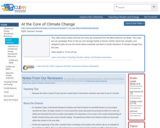
This video shows where and how ice cores are extracted from the West Antarctic Ice Sheet. The cores are cut, packaged, flown to the ice core storage facility in Denver, further sliced into samples, and shipped to labs all over the world where scientists use them to study indicators of climate change from the past.
- Subject:
- Archaeology
- Career and Technical Education
- Environmental Studies
- Physical Geography
- Physical Science
- Social Science
- Provider:
- CLEAN: Climate Literacy and Energy Awareness Network
- Provider Set:
- CLEAN: Climate Literacy and Energy Awareness Network
- Author:
- KQED
- Teachers' Domain
- Date Added:
- 09/24/2018


















